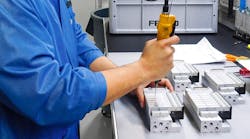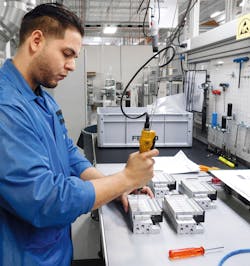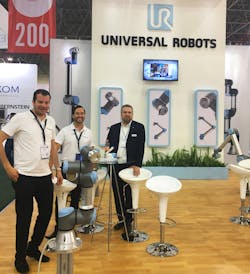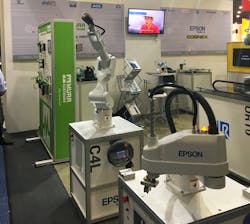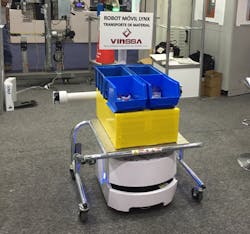This file type includes high-resolution graphics and schematics when applicable.
Last year proved record-setting for robotics in terms of orders and shipments in North America, according to the Robotic Industries Association (RIA). A total of 34,606 robots valued at approximately $1.9 billion were ordered in North America—a 10% jump from 2015. Orders for robots spiked 61% in assembly applications and spot welding saw a 24% increase. And orders for robots in the food and consumer goods industry rose by 32% in 2016.
These numbers represent North America as a whole, but some of these results are influenced by the surge in automation in Mexico. Consequently, companies like Festo are planning strategic locations for shipments to Mexico and even Central America. Festo recently published a news release stating that a facility in Cincinnati was strategically close to the airport to support the expected growth in Mexico, which is becoming a recognized hub for the automotive industry. Festo’s new center has Foreign Trade Zone status, making it faster and more efficient to support customers in the U.S., Canada, and Mexico from a central U.S. location.
With automation continuing on the upswing in North America , Machine Design talked to Jeff Burnstein, President of the Association for Advancing Automation (A3), about what this means for the U.S. and global competition.
What is your background?
I have been working to promote the use of robotics, machine vision, and motion control for more than 32 years. I see automation changing all facets of our lives for the better, creating new and better jobs, giving us higher-quality and lower-priced products, and helping us live longer and healthier lives.
How fast is Mexican automation growing?
With the world’s 11th largest economy, Mexico is home to a vast array of industries, including substantial automotive and aerospace manufacturing sectors. In 2015, industry-wide sales of robots in Mexico almost tripled to 6,320 units, exceeding $243 million. A3 is embracing Mexico’s broad-based growth and potential with this new association, which will help support Mexico’s rapidly growing automation industry. Automation investments can also help increase the number of well-paying jobs in Mexico, which has high rates of engineering graduates per capita.
How fast is automation growing in North America?
We [A3] just announced that 2016 North American robotics industry orders and shipments once again broke all-time records. In 2016, 34,606 robots valued at approximately $1.9 billion were ordered in North America, representing growth of 10% in units over 2015. The automotive industry experienced another strong year with orders growing 17%. Units shipped to North American customers also grew by 10%, with 30,875 robots valued at $1.8 billion shipped in 2016. Shipments into the automotive market grew 25% relative to 2015.
What does this foreshadow, or what can we expect from these numbers?
These numbers reinforce the vital role played by automation in spurring economic growth in North American manufacturing and services industries in 2016. We think this is only the beginning. As automation spreads around the world, companies everywhere will get more competitive, prices of products will come down, quality will go up, and demand will go up. For example, years ago you may have had one TV in your house. Today, due to reduced cost and increased quality, you might have five. I expect to see this happen with more products as automation becomes more prevalent around the world.
As things become cheaper, people will buy more and this will drive employment. Automation represents a strategic area for the global economy going forward, as it brings accelerated growth based on smarter, more mobile, and more collaborative robots in the coming years.
What is being produced in Mexico, or what are its markets?
The automotive, aerospace, and food and beverage industries are strong growth areas. With the boom of Mexican automation, it’s increasing any company's growth that works with robotics or advanced automation in the region too. In the past, some companies may have avoided Mexico, or only used it for a cheap labor. However, the automation in Mexico is becoming more advanced, with processes rivaling any other country. I was at Expo Manufactura in Monterrey, Mexico [Feb. 7-9], and there were many of the same robotics and advanced systems you would see in any show in the U.S.
This growth is also from multiple countries. Mexico has 10 free-trade agreements with 45 countries. U.S. companies that manufacture in Mexico can export tax-free to 45 countries that are not tax-free from the U.S.
What are the drivers pushing the Mexican automation market?
An increasing focus on efficiency improvement is one of the primary drivers of automation in Mexico. Industrial control devices are making it possible for organizations to standardize their production activities while cutting costs, reducing waste and improving safety.
Will this be a trend and will this move more U.S. jobs to Mexico?
A robust automation industry in Mexico will create jobs and broaden the Mexican middle class, providing the means and incentives for individuals to participate in Mexico’s growing economy. As Mexican purchasing power increases, it provides an expanding market for U.S. exporters. A strong Mexico is a robust and stable trading partner with its neighbors. U.S. companies will continue to automate as well, to help both small and large corporations be more globally competitive so that they can grow and fill new jobs in the U.S.
What does Mexico need to advance its automation—basic CNC or more advanced robotics, and machine vision?
Automation will allow Mexican companies to boost worker safety, reduce costs, decrease cycle time, improve quality, utilize space more efficiently, reduce waste, and stay competitive. A3 Mexico will promote the benefits of automation while facilitating gatherings and interchange between stakeholders and members of the automation community in Mexico. Mexico’s robust engineering and technical education programs throughout the country will lead to continued progress and expertise in advanced robotics, machine vision, etc.
While robots are popular, the biggest challenge is finding trained people who know how to set up and run the automated tools that are being installed in Mexican factories. They need highly trained, quality system integrators. This skills gap is an international problem. We are moving from jobs requiring less brawn to those with more brain power. Some skills will take a four-year degree, but most of it will be setting up and running the machines that can be taught in a technical school or a community college.
How is A3 helping this movement?
A3 is embracing Mexico’s growth and potential by forming a new association geared to this booming market. A3 is a global umbrella association for three leading industry associations that collectively form an ecosystem of automation: the Robotic Industries Association (RIA), Advancing Vision + Imaging (AIA), and the Motion Control & Motor Association (MCMA). In addition, every other year we host the Automate show.
A3 Mexico is dedicated to helping Mexican companies attain the advantages of automation so that they can compete more effectively on a global stage, resulting in economic improvements and safer, better conditions for workers. As a leading proponent of robotics, vision technology, motion control, and motors worldwide, A3 is helping develop the Mexican market for automation equipment suppliers along with system integrators. It’s also helping to develop better processes in Mexico that can improve product quality, consistency, and output to meet consumer demands.
What do you think the role of automation and robotics is globally?
Automation, which includes robotics, is coming front and center on the world stage, and has the potential to impact the global economy. As societies move forward, we have to embrace the changes and innovations introduced by technology and automation and learn to evolve with them. Today’s automation technologies—like every other technological revolution in the past—will change jobs and their required skills, and present opportunities for brand new jobs. Workers must begin now to prepare for that future, and governments and industries need to support that preparation.
How will automation increase the standard of living globally, or will it just help us make more stuff faster with less people?
Automation fundamentally changes everything and improves the standard of living globally. It’s not just about efficiency and productivity in manufacturing. Automation is speeding the development of new drugs and medical processes, improving surgical outcomes, and allowing products to be shipped faster. In the future, automation will even be saving lives on freeways and helping seniors and disabled individuals live more satisfying, independent lives.
